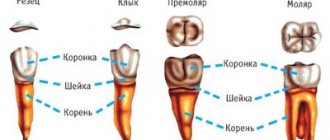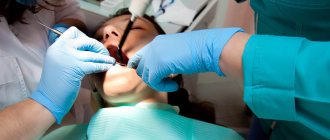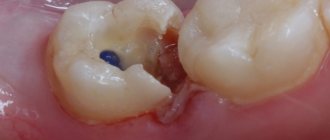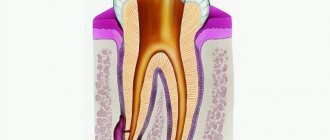Alcohol after dental treatment
The effect of alcohol on a treated tooth
How long after dental treatment can you drink alcohol?
Is it possible to drink carbonated or foamy drinks after dental treatment?
Is it possible to smoke after surgery?
A toothache can strike at the most unexpected moment, including before a planned feast. Is it possible to drink alcohol after dental treatment? What consequences can this lead to?
Why does a tooth from which the nerve has been removed hurt?
Patients often complain that the tooth from which the nerve was removed continues to hurt. This is a completely natural pain, the result of intervention in the body. In a couple of days the pain will go away. It can be observed when clenching teeth, when reacting to hot and cold. To reduce discomfort, take analgesic medications.
But if, due to improper treatment, the nerve was not completely removed, the pain and inflammation will return. It is possible that the canals were poorly treated, and there may also be an allergy to the filling material. It is necessary to go to the doctor immediately, since advanced inflammation can lead to tooth loss.
The tooth from which the nerve has been removed becomes dead, but it still remains and is not lost, so if you have a toothache, immediately go to the dentist. There is nothing to be afraid of - modern treatment is painless, and after it your diseased tooth will serve you for many years to come.
The effect of alcohol on a treated tooth
Some people think that alcohol after dental treatment additionally disinfects the oral cavity, but doctors say the opposite. After dental treatment, especially after treatment of pulpitis or periodontitis, the body needs rest. Not only the daily routine should be gentle, but also the diet, so at this time it is better to give up alcoholic beverages.
Let's tell you why.
- Alcohol can cause bleeding because alcohol dilates blood vessels and increases blood pressure.
- When drinking alcohol, the oral mucosa is irritated, the healing process slows down, and the risk of inflammation increases.
- Alcohol increases the load on the cardiovascular system and liver.
- Alcoholic drinks in combination with an anesthetic can cause headache, weakness, and convulsions.
Despite the fact that the effect of anesthesia wears off on average after two hours, the breakdown products continue to remain in the body for several more days.
Arsenic in the tooth: what to do if it still hurts?
Arsenic in dentistry is used to reliably kill the diseased nerve of the tooth. This technique has long been known and is slowly giving way to modern methods of anesthesiology. However, modern specialists still often practice the use of arsenic.
Arsenic in the tooth: the tooth hurts, you need to block the pain
In diseases such as caries, pulpitis or periodontitis, the inflamed dental nerve causes severe pain. In order to “kill” the diseased nerve, a special arsenic paste is used, the dosage of which is calculated individually for each patient. After putting the paste into the affected tooth, the doctor sets the time for the next appointment, which cannot be postponed. You can walk around with arsenic in your tooth for no more than three days!
What to do if there is arsenic in the tooth, but the tooth still hurts?
As a rule, arsenic quite quickly carries out the process of necrotization of the pulp, and the tooth stops hurting. But it also happens that there is arsenic in the tooth, but it still hurts. Most often, the pain after placing a temporary filling with arsenic subsides gradually over one to two days. If, after this period, the tooth continues to hurt, this can be caused by various reasons:
- pain is your body's reaction to the drug;
- temporary filling has an irritating effect;
- the doctor has chosen the wrong dosage of the drug for you;
- the medicine was installed incorrectly;
- osteonecrosis has occurred;
- the inflammation process has gone beyond the pulp.
In any of the indicated cases, you should immediately consult a doctor, because tooth pain that does not stop after arsenic is present is a very alarming sign.
What to do as first aid before you visit the dentist?
In order to relieve pain, we advise you to take some anti-inflammatory non-steroidal drug. For example, diclofenac, nurofen, ibuprofen, etc. Ordinary analgin can also help. Do not self-medicate under any circumstances - do not rinse the sore tooth with warm solutions and do not apply heat to the sore spot. If the pain is unbearable, and there is still a long time before visiting a doctor, you can try to remove the medicine yourself, but under no circumstances swallow or chew it, and after removing it, rinse your mouth thoroughly.
You can get a consultation at the DENTISTRY clinic. Make an appointment by calling +7 (8342) 308–088 or using the form below.
Make an appointment
Is it possible to drink carbonated or foamy drinks after dental treatment?
Gas is a constant irritant to the tooth, and foamy drinks (for example, kvass) contain yeast, which can get into the wound and cause discomfort. In addition, in the first days after tooth extraction, it is not recommended to drink drinks from straws. When sucking any drink, a vacuum is created in the mouth, which can tear a blood clot out of the hole.
Tooth nerve and need for removal
A tooth is not just a bone. In its roots there is a living pulp - blood vessels with nerve endings. This pulp is called the dental nerve; with its help, the tooth senses heat or cold. If the pulp is removed, the tooth dies, is not supplied with blood, is easily destroyed, and is less resistant to influence.
If a tooth is affected by caries, at first the destruction involves only dentin, the durable tissue of the tooth. But if caries is not treated in a timely manner, it will reach the pulp and pulpitis will begin. Then the pulp has to be removed - completely or partially, and if the pulpitis has reached periodontitis, the pulp has to be completely amputated. The nerve is also removed in case of mechanical destruction or prolonged pain.
Arsenic poisoning
Before doctors arrive, the victim should be induced to vomit. To do this, he is given 0.5-1 liter of clean water to drink, after which he is pressed with his fingers on the root of the tongue. The manipulation is carried out several times until a clean washing liquid begins to flow away, in which there are no foreign impurities. Next, the patient must be laid down and an influx of fresh air must be provided. For unconscious people, gastric emptying is contraindicated.
First aid
Acute arsenic poisoning requires first aid on the spot. The patient is advised to undergo gastric lavage using at least 10 liters of water mixed with adsorbent. After the procedure is completed, the patient is given 8-10 tablets of activated carbon and 50-100 ml of magnesium sulfate to drink as a laxative. An alternative is unithiol administered into the stomach through a tube. The same drug is infused intramuscularly.
At the prehospital stage, other measures are taken to maintain vital functions. To eliminate hypovolemia and correct electrolyte balance, infusion therapy is started. Anticonvulsants are used for seizures. In order to reduce pain, antispasmodics and analgesics are prescribed. Transfer to mechanical ventilation and titrated supply of vasopressors may be required.
Hospital treatment
Unithiol therapy continues in the hospital setting. The drug is prescribed in a course of 5-6 days. In its absence, the patient should receive N-acetylcysteine, which acts as a donor of monothiol groups. In case of damage by arsenous hydrogen, mecaptide is added to the regimen. Active methods of detoxification are required: intestinal lavage with the introduction of 8-10 liters of saline enteral solution into the intestines, hemodialysis, repeated gastric lavage.
After intestinal lavage is completed, the patient is given an antidiarrheal drug to drink. Infusion of saline solutions is required; in case of severe dehydration, infusion of colloids. Adult patients can receive fluids by mouth (rehydration solutions) as long as this does not cause vomiting. Additionally, glucocorticoids, ascorbic and nicotinic acid are prescribed. Severe metabolic acidosis is eliminated with sodium bicarbonate.
Recovery
After discharge from the hospital, the patient is recommended to be monitored by a local therapist to exclude the development of delayed consequences of chemical injury. It is possible to visit gastroenterological sanatoriums. Food must meet the requirements of table No. 4 according to Pevzner. Restrictions must be observed until the gastrointestinal tract is completely stabilized.
How to get arsenic out of a tooth?
In some cases, when it is not possible to visit the dentist at the appointed time, it is necessary to remove arsenic from the tooth yourself in order to avoid the negative consequences of the element’s influence on the body and oral cavity. This is quite simple to do, since the paste is fixed only with a temporary, rather unstable filling.
It is necessary to maintain maximum hygiene, so before removing arsenic yourself, you need to brush your teeth and treat your hands with an antiseptic. A temporary filling is easily broken by any sharp object. It is safest to use a wooden toothpick, additionally disinfected with alcohol. The arsenic paste in the pulp looks like a grayish ball; it must be taken out without crumbling it. If the integrity of the shell is damaged, the product will turn the tissue blue. This dye is specially added to the product for cases of filling loss. The pulp cleared of arsenic must be rinsed with any antiseptic. Even a decoction of chamomile will do. The pulp can be covered with cotton wool, and then make an appointment with the dentist as quickly as possible.
Types of temporary fillings
You cannot do without a temporary filling in the following cases:
- For conservative treatment of not too advanced pulpitis and advanced caries. After drilling out the inflammatory focus and treating the root canals, the tooth cavity is filled with anti-inflammatory drugs, and a filling is placed on top. This is necessary so that the drug does not leak out and that microbes and pieces of food do not get into the diseased tooth.
- For diagnosis in deep caries, when it is unclear whether the nerve is affected. They put a filling with medicine and watch the tooth - if it continues to hurt, most likely it is pulpitis.
- In the treatment of pulpitis, if there is a need to remove the nerve. Then the treatment is carried out in 2 steps: first, a filling is placed with arsenic or other, more gentle devitalizing drugs, and after the death of the nerve, treatment is carried out.
- For prosthetics and restoration to protect teeth while permanent structures are being made.
Installing a temporary filling is absolutely safe, except in cases where individual allergic reactions to filling materials are observed.
Temporary filling. What happens if you go with a temporary filling?
A temporary filling is placed on a tooth most often during root canal treatment (treatment of pulpitis or periodontitis - cysts). The main functions of a temporary filling are to isolate the medicinal material introduced into the root canals, prevent microbes and food particles from entering the tooth, temporarily restore the chewing function of the tooth, and strengthen the thinned walls of the tooth. The period for which a temporary filling is placed depends on what kind of medicine is in the root canals and what the initial diagnosis is. In some cases, the medicinal substance has strict restrictions on the period of application - for example, devitalizing pastes (arsenic analogues), which are injected into the tooth for 1-2 weeks in case of acute pulpitis, before removing the nerve and cleaning the root canals - in such cases, proceed with a temporary filling maybe a few days, a week at most. If you leave the devitalizing paste for a longer period, it will penetrate into the tissue surrounding the tooth and cause necrosis and inflammation of the periodontium - periodontitis.
If an antiseptic drug, for example, based on iodoform or calcium, is introduced into the root canals, then going with it is not so dangerous, but dentists still do not recommend leaving it for more than one month (in rare cases - three months), because when left in the canals for a long time, it dehydrates the hard tissues of the tooth, making the tooth more fragile. In addition, over time, the temporary filling may wear out, chip, lose its tightness (and the patient may not even notice it), while the medicinal substance will be washed out of the root canals, and an infection from the oral cavity will get inside the tooth, aggravating the problem (in this case, all Previous treatment and installation of a temporary filling will have to be repeated again).
If the root canals have already been filled with permanent material, and there is still a temporary filling on top, then it is also recommended to complete the treatment and restore the crown part of the tooth with a permanent filling, inlay or artificial crown within 1–3 months, because a dead tooth is very fragile, its walls can easily break off, the tooth can crack, and a temporary filling does not protect it from such situations. And if the temporary filling falls out or becomes leaky, then even microbes can leak into the root canals filled with permanent material, triggering the development of periodontitis (granulomas or cysts on the root of the tooth).
In any case, after installing a temporary filling, it is important to ask the dentist when it is necessary to continue treatment and clarify the maximum possible time for the temporary filling to remain in the tooth (in case of unforeseen circumstances and the impossibility of a visit on the appointed day).
Indications and contraindications for the use of arsenic
Arsenic is an aggressive pain reliever, so the main indication for use is fast and reliable pain relief . It is most often used when a patient comes in at night with severe pain. Also, such a remedy can become an alternative if the patient is allergic to the components of other anesthetics, as well as in cases where the body is resistant to the effects of other drugs.
A rarer indication for use is the person’s health status at the time of application. In some cases, it is not possible to use other anesthetics. For example, with high blood pressure or the presence of alcohol in the blood.
Since arsenic is a toxic agent, there are a number of contraindications to the use of the drug:
- Arsenic pastes are not usually used on primary teeth. If there is such an extreme need, then the minimum age should be 1.5-2 years;
- The presence of an allergy to any component of the paste also excludes the possibility of its use for the treatment of toothache;
- Diseases of the eyes, urinary and reproductive systems;
- Problems with root canals: curvature, unformed, disconnected.










